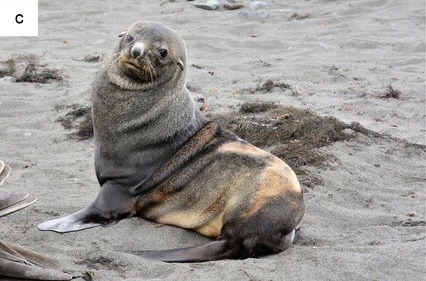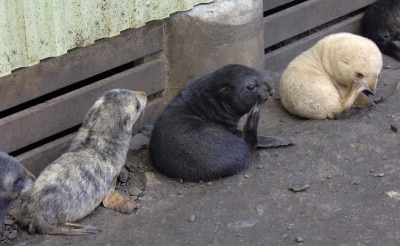Since Many Facilities Already Successfully Keep Bottlenose Dolphins In Sea Pens, Would It Be That Much
Since many facilities already successfully keep bottlenose dolphins in sea pens, would it be that much harder to build one for killer whales? Just curious.
In theory no… it would just need to be quite a bit larger! In practice, though, it would be more difficult. Bottlenose are right at home in warm coastal tropical and subtropical waters, like Florida, Hawaii, and the Caribbean. These places also draw tourists year round, which means constant income. Cetaceans are expensive to house, and sea pens require constant upkeep to prevent them from succumbing to the inevitable wear and tear of tides and salt.
A sea pen for orcas would need to be in much colder waters (which is why Sea Shepherd’s proposal to build a pen in the Mediterranean was ridiculous), which don’t tend to draw as crowds quite as big as tropical destinations. So you have much larger animals that need much more space, much more food, therefore much more money… but much less income. And that’s not even getting into the issues of staffing.
Since I’m assuming you’re referring to the idea of a sea pen for the orcas currently in captivity, I’ll touch on that briefly. Cetaceans that have spent their whole lives in highly filtered environments tend to have weaker immune systems than those in natural ocean water—one of the valid complaints about artificial tank habitats in my opinion. They just aren’t getting much antigenic stimulation. Some still do okay transitioning to sea pens, but others don’t, and it’s hard to predict how they’ll respond. And for some of the older individuals, like Katina and Corky, the stress alone of such a massive change might be too much.
So yeah, in theory, nothing wrong with a sea pen! In practice though, might be more difficult than many make it out to be.
More Posts from Fursealfan and Others


Aerial photos of J-pod socialising
Photos by SR3/SEA (source)
Begging you for some pinnipeds any pinnipeds please
Piebald Northern fur seal

Atypical colored Antarctic fur seal! With the orange, white, and grey they look calico.

Leucistic Antarctic fur seal

Interesting gang of Antarctic fur seal, one is leucistic and one almost looks brindle?

Leucistic southern elephant seal

Northern fur seal labeled as albino and partial albino (leucistic?) by some sources. NOAA says albino and they are experts.

Albino harbor seal

Albino ringed seal

Melanistic grey seal


kissy from mama

"Eavesdropping on whale songs over the last six years is providing new information vital to answering questions about these giants of the ocean.
The number of whale songs detected is associated with shifting food sources, according to the California scientists—and the number of days humpbacks have been singing has nearly doubled.
When monitoring baleen whale songs in the Pacific Ocean, researchers found year-to-year variations correlated with changes in the availability of the species they forage on.
In vast oceans, monitoring populations of large marine animals can be a “major challenge” for ecologists, explained Dr. John Ryan, a biological oceanographer at the Monterey Bay Aquarium Research Institute in California (MBARI).
Their team deployed underwater microphones called hydrophones to study and track baleen whales, which communicate over long distances through sound.
“Surprisingly, the acoustic behavior of baleen whales provides insights about which species can better adapt to changing ocean conditions,” said Dr. Ryan, a lead author of the study.
They also monitored songs from blue, fin, and humpback whales off the West Coast of the U.S. to see what the song data could reveal about the health of their ecosystem.
The findings, published in the journal PLOS One, showed “large” year-to-year variations in whale song detection.
“The amount of humpback whale song continually increased, with their songs being detected on 34% of days at the beginning of the study and rising to 76% of days after six years,” said Dr. Ryan.
“These increases consistently tracked improved foraging conditions for humpback whales across all study years—large increases in krill abundance, followed by large increases in anchovy abundance.
“In contrast, blue and fin whale song rose primarily during the years of increasing krill abundance.
“This distinction of humpback whales is consistent with their ability to switch between dominant prey. An analysis of skin biopsy samples confirmed that changes had occurred in the whales’ diets.”
He explained that other factors, including the local abundance of whales, may have contributed to patterns in song detections observed in some years, but changes in foraging conditions were the most consistent factor.
“Overall, the study indicates that seasonal and annual changes in the amount of baleen whale song detected may mirror shifts in the local food web.”
WHALES ON THE COMEBACK TRAIL: • Gray Whale, Extinct for Centuries in Atlantic, Is Spotted in Cape Cod • Sighting of Many Blue Whales Around Seychelles is First in Decades – ‘Phenomenal’ • Majestic Sei Whales Reappear in Argentine Waters After Nearly a Century
“The results suggest that an understanding of the relationship between whale song detection and food availability may help researchers to interpret future hydrophone data, both for scientific research and whale management efforts”, which could better protect endangered species."
-via Good News Network, March 1, 2025

let’s swim with mama
i love this "with mama" meme. mm yes give me more baby animals with mmama.

“The Navigator”
welcome to my blubbery blog!!! 🦭🦦🐋🐬🫧
i’m currently a volunteer at an AZA accredited aquarium, i hope to study marine environmental science in the future and work in conservation and education! my primary interests are in northern fur seal biology and southern resident killer whale behaviour, but i love all marine mammals!
i support accredited* zoos and aquariums! i do however hope that we can move away from them in the future. i think that conversations about the ethics of captivity are important and should always be centered around the wellbeing of the captive animals. i encourage caution and use of critical thinking around both anti and pro captivity arguments. i’m always happy to answer any questions about the practices of AZA accredited zoos and aquariums!
*there are some accredited zoos and aquariums (such as seaworld) that i am heavily critical of, but it’s unfortunately a complicated issue that isn’t realistic to have black and white opinions on.
marine mammal rescue, conservation, and research organisations:
alaska sealife is center
vancouver aquarium marine mammal rescue society
center for whale research
SR3
marine mammal care center
Today's Seals Are: Robot Uprising
-
 pacificpoison liked this · 3 weeks ago
pacificpoison liked this · 3 weeks ago -
 fursealfan reblogged this · 1 month ago
fursealfan reblogged this · 1 month ago -
 fursealfan liked this · 1 month ago
fursealfan liked this · 1 month ago -
 taylor-swift-as-a-cat liked this · 5 months ago
taylor-swift-as-a-cat liked this · 5 months ago -
 wildfeather5002 liked this · 6 months ago
wildfeather5002 liked this · 6 months ago -
 shitsngiggles666 liked this · 6 months ago
shitsngiggles666 liked this · 6 months ago -
 weefslider liked this · 6 months ago
weefslider liked this · 6 months ago -
 orcinusorka reblogged this · 6 months ago
orcinusorka reblogged this · 6 months ago -
 orcinusorka liked this · 6 months ago
orcinusorka liked this · 6 months ago -
 luminous-starry-eyes liked this · 7 months ago
luminous-starry-eyes liked this · 7 months ago -
 mercygetbackhere liked this · 7 months ago
mercygetbackhere liked this · 7 months ago -
 justaquietnerd liked this · 7 months ago
justaquietnerd liked this · 7 months ago -
 pa-pa-plasma reblogged this · 7 months ago
pa-pa-plasma reblogged this · 7 months ago -
 pa-pa-plasma liked this · 7 months ago
pa-pa-plasma liked this · 7 months ago -
 rk800f liked this · 7 months ago
rk800f liked this · 7 months ago -
 bus-noises reblogged this · 7 months ago
bus-noises reblogged this · 7 months ago -
 bus-noises liked this · 7 months ago
bus-noises liked this · 7 months ago -
 a-minke-whales-tale liked this · 7 months ago
a-minke-whales-tale liked this · 7 months ago -
 mischiefseven liked this · 7 months ago
mischiefseven liked this · 7 months ago -
 scruffydogcreative reblogged this · 7 months ago
scruffydogcreative reblogged this · 7 months ago -
 scruffydogcreative liked this · 7 months ago
scruffydogcreative liked this · 7 months ago -
 luminesnake liked this · 7 months ago
luminesnake liked this · 7 months ago -
 merlot-and-rainstorms liked this · 7 months ago
merlot-and-rainstorms liked this · 7 months ago -
 nerdgirlnarrates liked this · 7 months ago
nerdgirlnarrates liked this · 7 months ago -
 thehollyraven liked this · 7 months ago
thehollyraven liked this · 7 months ago -
 cmipalaeo liked this · 7 months ago
cmipalaeo liked this · 7 months ago -
 warriors-synpaths reblogged this · 7 months ago
warriors-synpaths reblogged this · 7 months ago -
 queenmosworld liked this · 7 months ago
queenmosworld liked this · 7 months ago -
 orca-in-disguise liked this · 7 months ago
orca-in-disguise liked this · 7 months ago -
 ravenrae8 liked this · 7 months ago
ravenrae8 liked this · 7 months ago -
 2woodroses liked this · 7 months ago
2woodroses liked this · 7 months ago -
 ibroughtyouthemoon liked this · 7 months ago
ibroughtyouthemoon liked this · 7 months ago -
 grapecigarillos liked this · 7 months ago
grapecigarillos liked this · 7 months ago -
 mongrelmutt liked this · 7 months ago
mongrelmutt liked this · 7 months ago -
 chainights reblogged this · 7 months ago
chainights reblogged this · 7 months ago -
 chainights liked this · 7 months ago
chainights liked this · 7 months ago -
 adelphicoracle liked this · 7 months ago
adelphicoracle liked this · 7 months ago -
 fisheatingorca reblogged this · 7 months ago
fisheatingorca reblogged this · 7 months ago -
 fisheatingorca liked this · 7 months ago
fisheatingorca liked this · 7 months ago -
 swirlingyouintomypoems liked this · 7 months ago
swirlingyouintomypoems liked this · 7 months ago -
 happinessisntfun liked this · 7 months ago
happinessisntfun liked this · 7 months ago -
 orcinus-veterinarius reblogged this · 7 months ago
orcinus-veterinarius reblogged this · 7 months ago

